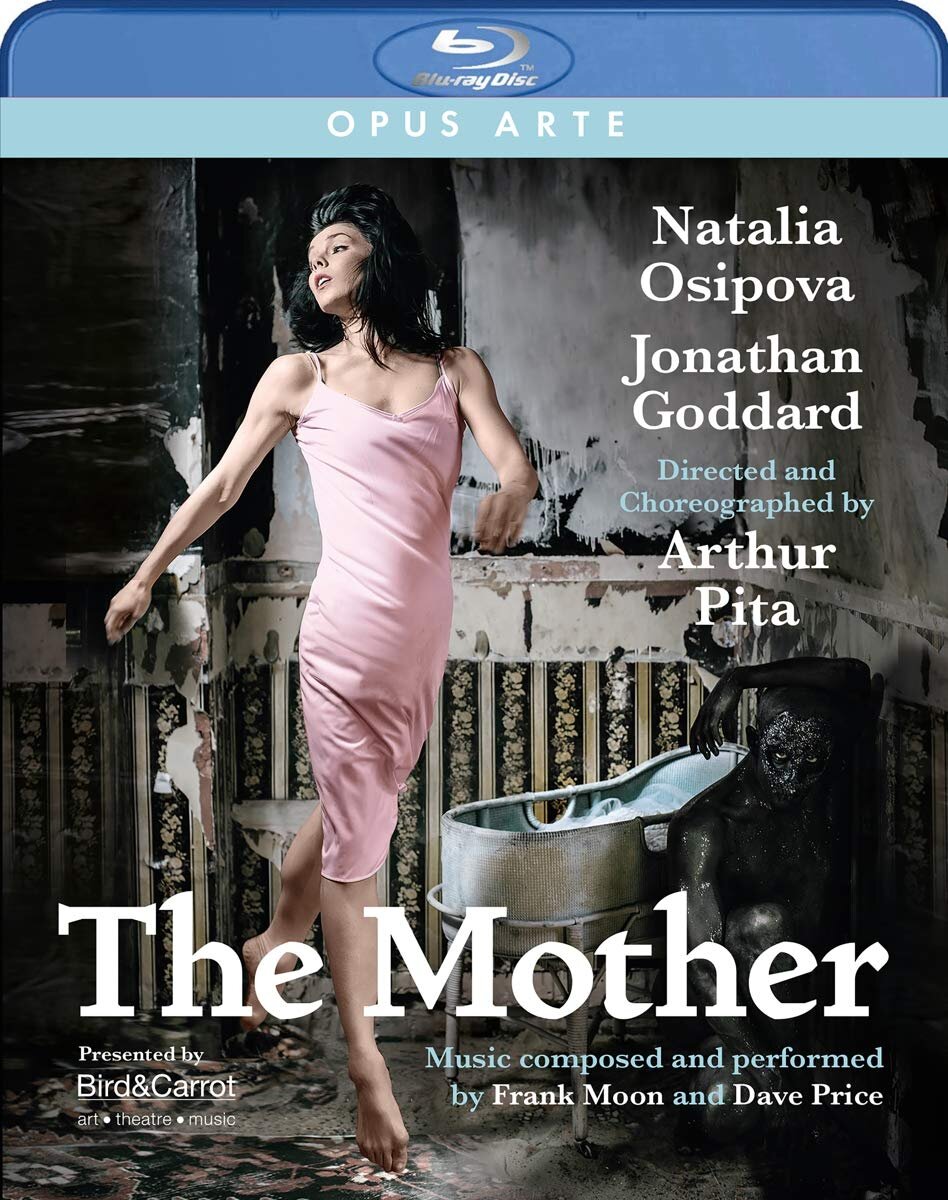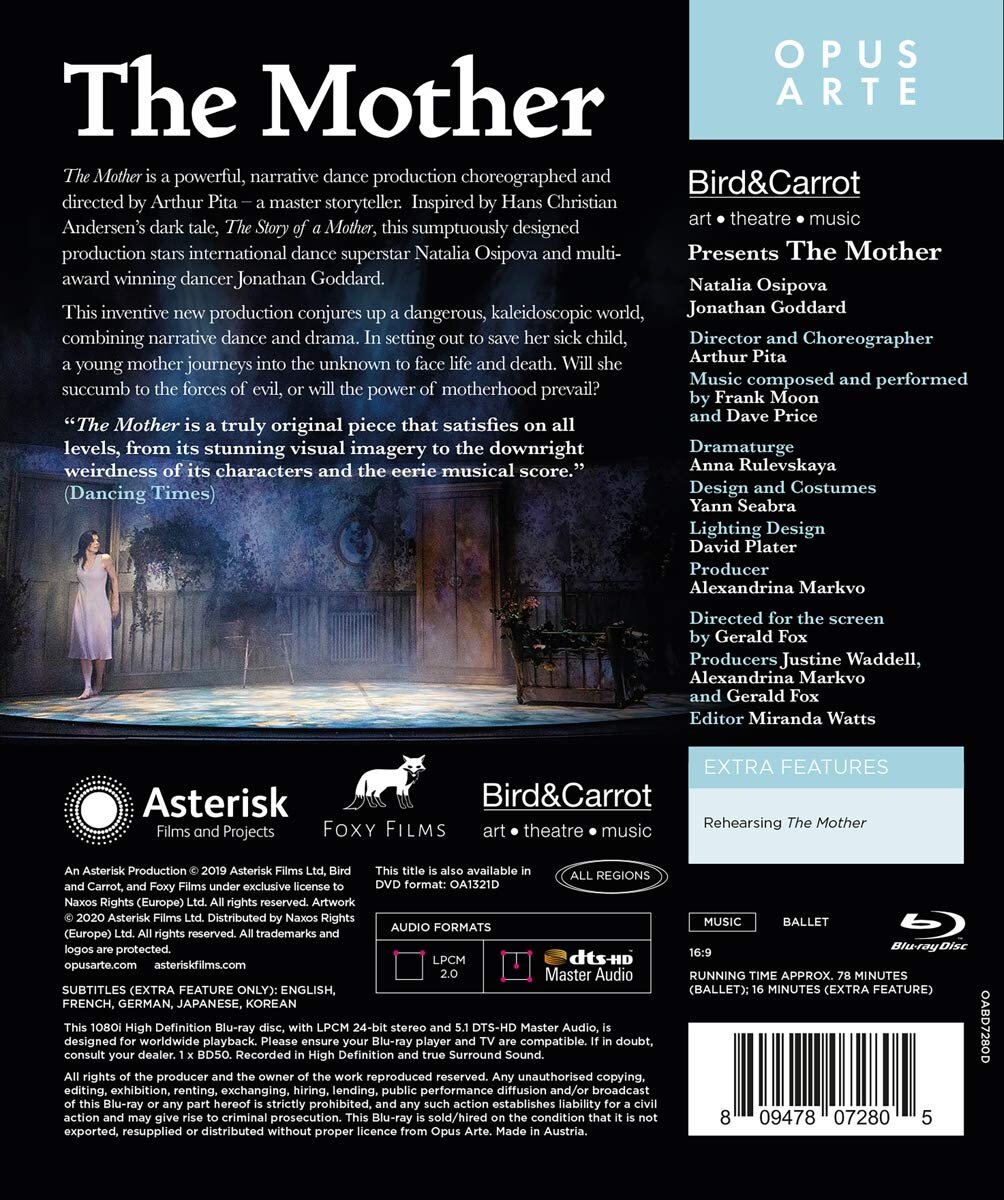

The Mother dance production inspired by the Hans Christian Andersen fairy tale, The Story of a Mother. Directed and choreographed in 2019 by Arthur Pita at the Queen Elizabeth Hall in London. Original music composed and performed by Frank Moon and Dave Price. Stars Natalia Osipova in the role of the mother and Jonathan Goddard playing all other characters that appear, i.e., death, the babushka, the bramble bush, etc. Set and costume design by Yann Seabra; lighting design by David Plater; dramaturgy by Anna Rulevskaya. Stage production by Alexandrina Markvo (Bird&Carrot). Directed for TV by Gerald Fox; edited by Miranda Watts. Produced for TV by Justine Waddell, Alexandrina Markvo, and Gerald Fox. The keepcase booklet has a nice English translation of The Story of a Mother. Brief passages sung and spoken in Russian (no subtitles). Released 2020, disc has 5.1 dts-HD Master Audio sound. Grade: A+
This may be the biggest risk Opus Arte ever took, and it’s about as close as this semi-retired lawyer in Dallas, TX will ever get to the London avant-garde theater scene. It appears “Bird&Carrot” is an assumed name for Alexandrina Markvo, a female theater impresario in London. She is, I think, a 35-or-so-years-old dual British-Russian citizen who has been involved in a long list of creative and/or wild art-theater events like Pussy Riot recitals. Pita and Moon are, of course, the artists who worked up The Metamorphosis to blast Ed Watson into the theatrical jet stream dancing the role of a giant cockroach! Now Pita and Moon will try to do something similar for Osipova and Goddard. Natalie can dance, of course, just about anything as well as anyone, but she appears to want to raise as much hell as possible before age or injury forces her to retire. This opened in Edinburgh in December 2018. It played briefly in Moscow. It played next 3 times in London in June 2019, and Gerald Fox made his recording on June 20. I’m guessing it’s been seen fewer than 10 times live and by fewer than 5000 people. If this Opus Arte show becomes a hit, maybe this could even get this production into the black? If it does, then maybe we will get more Blu-rays of “experimental” modern dance works!
If you buy this disc, I suggest you watch it cold first (it’s not too long at 78 minutes) and see how you do. Then read the fairy tale in the keepcase booklet and things will start snapping into focus. Of course, there is some material in the dance show that is not in the fairy tale and vise versa. And at the end of this review, I have a few observations as to how our understanding of this story of a mother may have changed even since this show premiered in June 2019! On to screen shots!
We open with a shot of Frank Moon on the side of the stage. There is no one in a pit:
On the other side of the stage is Dave Price. He and Moon will provide all the music and sound effects for the entire show with their amazing collection of instruments and sound makers:
The set is an apartment in Moscow in the 1960s. The mother (Natalia Osipova) has been awake with her sick baby for three days and nights. She is a single mom who has been abandoned by her lover. She can’t find a doctor. Suddenly Death enters unannounced and disguised as a physician:
Death gives the mother a potion to put her to sleep and steals the baby!
After the mother wakes, she frantically looks for her child and sees it is gone. A strange, faceless babushka, or Russia grandmother (Jonathan Goddard), offers a clue as to which way Death went with the baby. But the clue comes with a price: the mother must dance all the old folk dances with babushka. Here Osipova helped with the choreography by remembering the dances she learned as a little girl:
The next image below comes from Bird&Carrot PR. I couldn’t get a decent screenshot from the nonstop, frantic folk steppings of Osipova and Goddard:
With a clue earned from the babushka, the mother begins her search for the baby. She soon meets a huge bramble bush covering all the paths and trails in the snow-covered Russian forest. The mother asks the bush for another clue. The bush offers to help, but first the mother must take the bush to her breast and warm it so the bush will not freeze. This the mother does at a terrible cost of lost blood where the brambles cut her flesh:
The clue from the bush leads the mother to a vast lake with no boats or other signs of life. The mother will try to drink the lake dry. But the lake, here represented by a sailor in foul weather gear, objects. The lake is blind and admires the mother’s beautiful eyes. The lake offers safe passage and another clue in exchange for the mother’s eyes. The mother has no choice: she gives up her eyes:
And now the lake can see:
Next below, an image from the Dance of the Blind:
After crossing the lake, the mother encounters an old white witch. The witch has a further clue about the path of Death, but what can the mother offer the old hag? The only thing she has left is her beautiful black hair:
The next image is from the lament of the mother now bereft of all her beauty:
Suddenly the mother’s lover appears:
The lover has come to return tp the mother her eyes, but then he again disappears:
Leaving the mother alone again:
From Death’s Solo:
The White Witch gave the mother a clue about Death’s Hothouse with his Garden of the Innocents:
The mother searches for her innocent:
But she learns she must give up her innocence for ever:
At this point, I think I’ve shown you more than enough for you to decide if this title is something you want to see. I’ll go further to say that the PQ is great. The music and sound effects fully support all the action on stage and are recorded with plenty of pop. Go back through the screen shots and note how many color combinations of lights are deployed by David Plater. And consider how much information is generated here by just two dancers and two musicians. In that regard I can’t think of any other Blu-ray title with so much bang for such economical resources marshaled by the producers.
I did a Ballet Wonk Worksheet on half the chapters in the video (7 of 14). While working on this, I had the strong impression that the video pace produced by Fox as TV director and Miranda Watts as editor would to be too fast and result in a penalty in grading. Wrong! Even the chapters full of fast action had a pace of almost 10 seconds per clip. Chapters 11 and 12, with less frantic dancing, yielded a pace of 14 seconds per clip. Also, Fox did a great job is getting the whole bodies of his dancers in 72% of the chapters scored on my worksheet. I wouldn’t call the video pace here elegant exactly, but the video can’t be marked down for DVDitis or hyperactivity disorders.
But that’s not all to marvel at. What I’ve revealed above is roughly consistent with Andersen’s story published 1847. But Pita and dramaturge Anna Rulevskaya have a happy ending in store for you, which I would not now spoil for anything. To find out what happens to the mother today, you just have to get the disc! And who is the curious creature below who suddenly appears in this bleak Moscow apartment? To figure this out, you will need to read the stuff in the keepcase art:
In conclusion, I have a few more words to say about the deeper meaning of this story of a mother. Various theories have been offered about this work as literature. But nobody else seems to have figured out that this tale is really about mothers vs. microbes. When Andersen published his story in 1847, infectious diseases killed huge numbers of people every year, especially children. Healthy mothers in America were expected to have anywhere from 5 to 15 children each to keep the population growing. The era of antibiotics began roughly about 1942 when I was a toddler. So in my lifetime, I only remember one child who died from an infection.
The lesson of Andersen’s tale in 1847 was, of course, that people had to accept the will of fate, or of God, when children died from sudden diseases. But that lesson became obsolete in the era when medical experts started to believe that humans in modern societies would never again fear infections. This thinking would be fully consistent, of course, with the happy ending to the mother’s story dreamed up by Pita and team as recently as June 2019 then subject title was last performed live. The mothers had won the war with the microbes.
But just 6 months later, a completely new infectious disease emerged that now is rapidly spreading and killing a lot of people, though thankfully not so many children. So I just finished reading Laurie Garrett’s frightening 750 page tome on The Coming Plague, where it is explained that the microbes (especially the “super-bugs”) are mounting a broad counter-attack on the mothers. Death may soon be stealing children again, and The Story of a Mother may once again be just as obviously pertinent as it was in 1847.
Here an official trailer from Bird&Carrot about the theatrical production:
OR























